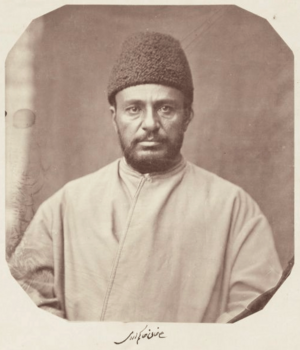Ali Khan Vali facts for kids
Quick facts for kids
Ali Khan Vali
|
|
|---|---|
 |
|
| Born | 1262 Hijri (c. 1845 CE) |
| Died | 1318 Hijri (c. 1901 CE) Tehran, Iran
|
| Nationality | Iranian |
| Occupation | Photographer, governor |
| Children | Gassem Khan, Heydar Goli Khan |
| Parent(s) | Mohammad Gasem Khan Vali |
Ali Khan Vali (Persian: علی خان والی, born around 1845 CE, died around 1901 CE) was an important Iranian photographer and a leader in government. He lived during the time of Naser al-Din Shah and Mozaffar ad-Din Shah, who were kings from the Qajar family.
Contents
Biography
Early life
Ali Khan was born in Tehran, Iran, in 1845. His father, Mohammad Gasem Khan Vali, was a diplomat. When Ali Khan was young, he lived in Russia with his father. There, he learned many subjects like French, history, geography, and geometry. He also learned the exciting new art of photography.
His father, Mohammad Gasem, later became a governor in Gilan. He did many good things there, like improving law enforcement and building roads. Because his father was often a governor, the family became known as "Vali," which means "governor" or "ruler." This became their family name.
Governor of Maragheh
In 1868, Ali Khan became a special helper at the royal court. The next year, he traveled to Karbala with Naser al-Din Shah.
Later, in 1879, Ali Khan was chosen to be the governor of Maragheh. He started taking photos on his way to Maragheh. He even took pictures of the city hall and local leaders.
During his time as governor, Ali Khan made Maragheh much safer. The city had problems with thieves. Ali Khan personally went out at night with his helpers to catch them. He worked hard until the city was free from crime. This made the people feel much more secure.
After about twenty months in Maragheh, Ali Khan moved to Tabriz. He then helped supervise a special meeting called the Public Majlis of Azerbaijan. This meeting was formed to keep order in the region.
Governor of Urmia and Khoy
Ali Khan later became the governor of Urmia. He stayed in this role for a few years. After that, he was appointed governor of Khoy and Salmas.
In Khoy, he made many improvements to the city. He helped pave streets, fix up the city hall, and rebuild the Grand Bazaar. He even sent Shah Naser al-Din Shah special reports with pictures of his work. The Shah was very pleased with his efforts.
In 1883, Ali Khan brought his 15-year-old son, Gasem, to Khoy. He set up a special school in the government building just for his son's education.
Later, Ali Khan was reappointed as governor of Urmia. There were some problems in the region, but Ali Khan quickly brought peace back. Because of his good work, he was given the special title Jinab. During this time, he also took on Ali Agha as his photography student. Together, they added many new photos to his collection.
Governor of Ardabil
When Naser al-Din Shah returned from a trip to Europe, Ali Khan welcomed him. The Shah then made Ali Khan the governor of Ardabil.
In Ardabil, Ali Khan faced some challenges. He had a small disagreement with some market sellers about moving their businesses outside the city.
Later, in 1897, Ali Khan was asked to be governor of Ardabil again. There were big disagreements between different groups of people in the city. Ali Khan tried to solve these problems. He even had to arrest one leader for a short time to bring peace.
Sadly, Ali Khan became very ill in Ardabil. He left for Tehran to get medical help.
Death
After being sick for three years, Ali Khan Vali passed away in Tehran in 1901.
Personal life
Ali Khan loved to exercise and stay fit. He was very strong! A person named Dust-Ali Mo'ayyeri described his strength:
Ali Khan Vali was skilled in exercises like club swinging, Kabbadeh, push-ups and wrestling. He practiced every morning and evening in his private gym. He could even rip a carpet apart with his hands and bend copper items into tubes!
Ali Khan Palace
Ali Khan built a beautiful summer home and a large garden in a village near Tehran. In the summer, he would invite important people and ministers to his garden for big parties.
Later, Ali Khan's son, Gassem Khan, built another mansion next to the mountain. This garden and the mansions became known as Ali Khan Palace. Much later, during the Pahlavi era, this palace became part of the famous Sa'dabad Complex.
See also
- Culture of Iran
- Islamic art
- Iranian art
- Iranian art and architecture
- List of Iranian artists

